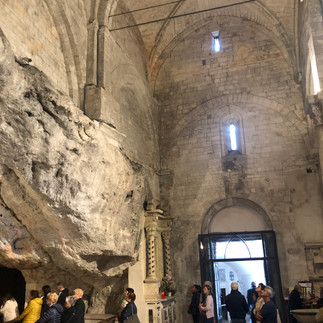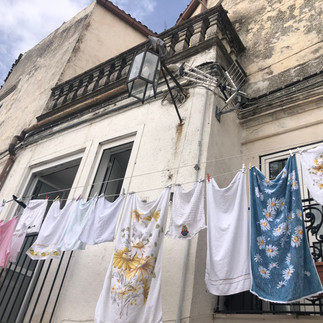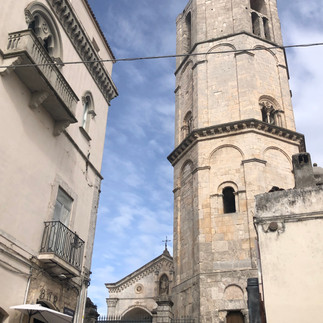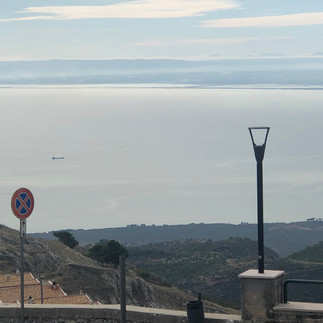Travel: Gargano, Mt.St. Angelo, Italy. Oct 18-19/2023
- Lili Naveh
- Oct 18, 2023
- 4 min read
Updated: Mar 6, 2024
A continuation of a trip that started on Oct 3rd/2023
Originally the trip to Italy was due to end much earlier, however due to the lingering Israel/Hams war, returning to Israel was not possible, thus our stay got prolonged
in Italy, until airline tickets and re-routing the return, from Rome to Ca. could be attained.
While Italy became our temporary refuge, during this very uncertain times, our family was dispersed in 3 continents. Inbal- our younger daughter and her family, who initially traveled with us, found safety in Mexico, but the older one - Keren and her husband about whom we worried sick, remained put in Israel.
Driving slowly back North, in a rainy color weather, the plan was to spend few days at the territorial blip of Gargano penninsula - a historical and geographical sub-region in Puglia, on the Adriatic eastern side, and much less known to the international tourists.

The drive from Gallipoli at the Italian tip of the hill, up North to the small Gargano
spur, which projects into the sea on the Italian "boot". took about 4 hours

On the way and prior to proceeding to the peninsula, having a great lunch at a small historic town (north of Bari) named Molfetta , was worthwhile the stop there.

Restaurant Adriatico -best seafood
Via Giovinazzo, 70056 Molfetta BA

Gargano Peninsula


This sub region consists of most diverse landscapes. Wide isolated mountain massif made of highland and several peaks ( high point is Monte Calvo at 1,065 m) forms the backbone of the Gargano Promontory

White limestone cliffs plunge into the aquamarine sea, small towns dots the top of
these cliffs, thick forest and groves of olive trees cover the interior section
of the peninsula. and 2 major salt lakes of Lesina and Varano - lagoon lakes, are located in the northern national park's part.


Sea caves dot the limestone cliffs, with occasional breaks in the cliffs for rocky and numerous sandy beaches and tourist facilities, including resort towns, as most charming Vieste, , which we stayed in and others as Peschici and Mattinata.

Gargano National Park, founded in 1991. is partly covered by the remains of an ancient forest, Foresta Umbra, the only remaining part in Italy,
The peninsula also consists of most colorful salt pans amazing to view
Driving along these most colorful salt pads is an amazing experience

The Margherita di Savoia Salt Pans:
About 20km long with 4500 hectares of surface area, the “Saline” are called in honor of the first queen of Italy in 1879 and are the biggest ones in Europe and the second ones worldwide after the Bolivian salt pans.
Designed by Vanvitelli, these most important salt-works in Europe, are the heart of salt production, but also a natural area rich in biodiversity.
Sea salt farming, handed down through the centuries, typically follows a five-year cyclical harvesting method so that in each shallow pond that makes up the salt-pan, the salt begins to crystallize into a crust that reaches a thickness of about 50 cm.
The production process begins with the collection of water in the evaporation ponds, the closest to the coast. From there the water is piped through canals to an area of about 3,500 hectares, where the evaporation process begins, thanks to the combined action of solar radiation and ventilation.
From pink to violet to blue the colors of the Margherita di Savoia Salt Pans, at the protected natural area are absolutely stunning.
The way up the mountains to Mt .St Angelo following a winding road with an impressive viewpoint over the Gulf of Manfredonia, is also worth the visit

Monte Sant'Angelo - A Holly Pilgrimage Site

The site of the oldest shrine in Western Europe is here, dedicated to the archangel Michael, Monte Sant'Angelo sul Gargano, were we also spent a night.

This beautiful 11 c steep village is situated high up on the southern slopes of Monte Gargano.. Between 1081 and 1103, Monte Sant'Angelo was the capital of a large Norman dominion under the control of Count Henry, who was a vassal of the Byzantine Empire. The grotto which houses the Sanctuary of Saint Michael the Archangel where according to legend, St. Michael appeared in 490, 492 and 493, has been the site of many famous pilgrimages, which started from Mont Saint-Michel.
Pope John Paul II visited the sanctuary in 1987.
The Castle is the dominant view in the town

The Castle, with bastions of different ages. The most ancient part, called Torre dei Giganti ("Giants' Tower") is a pentagonal tower


The Sanctuary of Saint Michael the Archangel is the symbol of the town .
This Roman Catholic shrine which as of 2011, became a UNESCO World Heritage
and the oldest shrine in Western Europe is dedicated to the Archangel Michael and has been an important site of pilgrimage since the early Middle Ages.
A flight of steps carved into the rock leads to the Sacra Grotta, the site of the apparition of the Archangel.

The impressive Grotto praying chamber was largely attended in the middle of the week when we visited there, briefly.
At the village itself


Palace Hotel San Michelle we stayed in is part of a complex located in what, at the beginning of the '900, was a historic residence, In the heart of the Gargano National Park, It sits on two hillsides, surrounded by olive groves and forests,


When strolling through the village's main street, this deliciously creative bakery is not to be missed
Via Giuseppe Garibaldi, 15,

The view from the top of the village

Outside the town's center is the enveloping nature of the Umbra Forest with its beech forests, also a UNESCO World Heritage Site.
To be continued....













































Comments